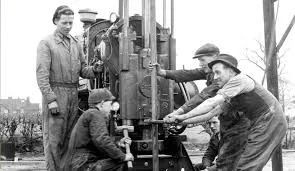Underground directional drilling is not a new concept, although the technologies and techniques have improved significantly since its beginnings, stemming back to the 1900s, where it was used predominantly in the oil and gas industry.
Horizontal directional drilling now has residential, commercial and industrial uses, including drilling to difficult-to-access locations to allow conduits and cables to be laid over large areas of ground, minimising associated costs and environmental impact.
Although the technology has come a long way, directional drilling has its origins in the oil fields of the early 20th century, when the oil industry started to become aware that the wells they were drilling weren’t going straight down! Upon surveying the holes, the operators discovered they were unknowingly drilling holes with up to a 50° +/- inclination.
This deviation was found to be caused by formation dips, faults and bedding planes acting on the drill bit as well as the bending characteristics of the drillstring coupled with the amount of weight applied to the bit.
Among the first attempts used to figure out the deviation of the boreholes was the “acid bottle technique” developed in the 1800s in South African diamond mines: A glass bottle filled with acid would be lowered into the borehole, where the acid would settle at an angle in the bottle lying parallel to the angle of the inclination. The acid would etch the glass, allowing the surveyors to calculate the angle of the bore’s inclination at a given depth.
The urgency to improve surveying methods in the oil fields was accelerated by the possibility that oil wells were crossing lease lines and tapping into each other’s oil reserves. Over the next century, directional drilling surveying techniques went from strength to strength, as more comprehensive technology was developed and became available to be tested.
With today’s digital technology, the angle of the drillbit can be controlled with great accuracy, availing operators of real-time data on the surface as the work takes place.
Directional drilling is now an integral part of many operations, as the technology and machinery continues to improve. The directional drilling industry continues to grow, meeting a modern demand for a centuries-old science.
